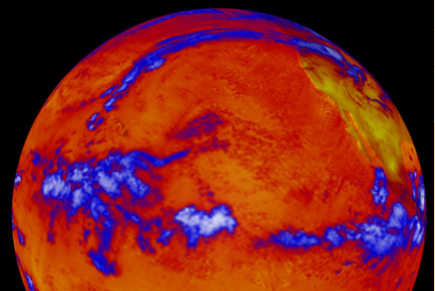Quiz: Global warming - Questions and Answers
Test your knowledge about global temperature change and its impact on Earth's climate.
Test your knowledge about global temperature change and its impact on Earth's climate.
1. The six hottest years on record occurred during the last:

A. 100 years
B. 50 years
C. 10 years
2. No place on Earth is colder today than it was 100 years ago.

A. True
B. False
3. Which of the following gases does not trap heat?

A. Carbon dioxide
B. Nitrogen
C. Water vapor
D. Methane
4. As average global temperature rises,

A. Average precipitation increases
B. Average precipitation decreases
C. Average precipitation is unchanged
5. Where have some of the strongest and earliest impacts of global warming occurred?

A. In the tropics
B. In northern latitudes
C. Impacts of global warming are distributed equally all over the planet.
6. Compared to other greenhouse gases, carbon dioxide is the most effective at trapping heat near the Earth's surface.

A. True
B. False
7. Some kinds of pollution in the atmosphere can act to cool the planet by reducing the amount of solar radiation that reaches Earth's surface.

A. True
B. False
8. Earth has been warmer in the past than it is today.

A. True
B. False
9. If you removed the atmosphere's natural greenhouse effect, and everything else stayed the same, Earth's temperature would be:

A. 10 to 20°F (6 to 11°C) warmer
B. 30 to 40°F (17 to 22°C) warmer
C. 10 to 20°F (6 to 11°C) cooler
D. 50 to 60°F (28 to 33°C) cooler
7. Some kinds of pollution in the atmosphere can act to cool the planet by reducing the amount of solar radiation that reaches Earth's surface.

A. True
B. False
8. Earth has been warmer in the past than it is today.

A. True
B. False
9. If you removed the atmosphere's natural greenhouse effect, and everything else stayed the same, Earth's temperature would be:

A. 10 to 20°F (6 to 11°C) warmer
B. 30 to 40°F (17 to 22°C) warmer
C. 10 to 20°F (6 to 11°C) cooler
D. 50 to 60°F (28 to 33°C) cooler
10. How do scientists collect evidence about climate?

A. Using remote sensing from space with satellites
B. By ground-based measurements of surface temperature, carbon dioxide concentration and sea level
C. By collecting "proxy data" from tree rings, ice cores and historical records
D. All of the above

A. Using remote sensing from space with satellites
B. By ground-based measurements of surface temperature, carbon dioxide concentration and sea level
C. By collecting "proxy data" from tree rings, ice cores and historical records
D. All of the above
Answers
1. C. 10 years. According to NASA's Goddard Institute for Space Studies, 2009 was only a fraction of a degree cooler than 2005—the warmest year on record—and was tied with a cluster of other years—1998, 2002, 2003, 2006 and 2007—as the second warmest year since record-keeping began. January 2000 to December 2009 was the warmest decade on record.
2. B. False. Although most locations on the planet have recorded increased temperatures since 1900, changes in global ocean and atmospheric circulation patterns have created small-scale temperature decreases in a few local regions.
3. B. Nitrogen. Heat-trapping greenhouse gases absorb and emit radiation within the thermal infrared range. Water vapor, carbon dioxide and methane are Earth's most abundant greenhouse gases. Nitrogen, which makes up 80 percent of Earth's atmosphere, is not a greenhouse gas. This is because its molecules, which contain two atoms of the same element (nitrogen), are unaffected by infrared light.
4. A. Average precipitation increases. Higher temperatures give rise to a more active water cycle, which means faster and greater evaporation and precipitation and more extreme weather events.
5. B. In northern latitudes. Some of the fastest-warming regions on the planet include Alaska, Greenland and Siberia. These Arctic environments are highly sensitive to even small temperature increases, which can melt sea ice, ice sheets and permafrost, and lead to changes in Earth's reflectance ("albedo").
6. B. False. Water vapor actually has more heat-trapping power than carbon dioxide. It is also more abundant. But carbon dioxide and water vapor interact in crucial ways: More carbon dioxide means the atmosphere gets warmer, which then creates more water vapor, which traps heat and warms the atmosphere even more.
7. A. True. Air pollution can take the form of fine particles called "aerosols," which both absorb and scatter the sun's radiation. Both natural and man-made aerosols, such as dust, sea salt, soot and sulfates, affect the climate by reflecting radiation that is transmitted through the atmosphere.
8. A. True. Global temperatures during past interglacial periods have exceeded the average temperatures we observe today, although you would have to go back more than three million years to find a period that was clearly warmer than today.
9. D. 50 to 60°F (28 to 33°C) cooler. The greenhouse effect is a naturally occurring physical process that warms the Earth's surface with energy from the atmosphere. Without the effect, Earth's average surface temperature would be well below freezing.
10. D. All of the above. For the past few decades, scientists have had the benefit of global satellite data. We have accurate ground-based measurements that reach back just over a century. "Proxy" methods, such as tree ring and ice core analysis, are used to reconstruct climate records before the rise of modern instruments.
Credit: NASA Climate Change website.